Converting moles to grams - Samenvattingen en Aantekeningen
Op zoek naar een samenvatting over Converting moles to grams? Op deze pagina vind je 76 samenvattingen over Converting moles to grams.
Alle 76 resultaten
Sorteer op
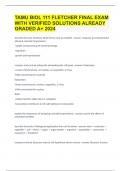
-
TAMU BIOL 111 FLETCHER FINAL EXAM WITH VERIFIED SOLUTIONS ALREADY GRADED A+
- Tentamen (uitwerkingen) • 36 pagina's • 2023
- Ook in voordeelbundel
-
 BRAINBOOSTERS
BRAINBOOSTERS
-
- $14.99
- 1x verkocht
- + meer info
describe the basic functions all life forms must accomplish -response to environmental stimuli & maintain homeostasis -uptake and processing of nutrients/energy -regulation -growth and reproduction compare and contrast eukaryotic and prokaryotic cell types Prokaryotes: -circular chromosomes, no nucleus, no organelles, 3.5 bya -DNA concentrated in nucleoid Eukaryotes: -linear chromosomes, nucleus, organelles, 1.5 bya -DNA concentrated in nucleus Both: -cellular function takes p...
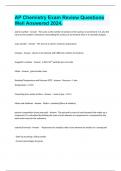
-
AP Chemistry Exam Review Questions Well Answered 2024.
- Tentamen (uitwerkingen) • 27 pagina's • 2024
-
Ook in voordeelbundel
-
 TestSolver9
TestSolver9
-
- $7.99
- + meer info
atomic number - Answer The same as the number of protons in the nucleus of an element; it is also the same as the number of electrons surrounding the nucleus of an element when it is neutrally charged. mass number - Answer The sum of an atom's neutrons and protons isotopes - Answer Atoms of an element with different numbers of neutrons Avogadro's number - Answer 6.022×10²³ particles per one mole Moles - Answer grams/molar mass Standard Temperature and Pressure (STP)...
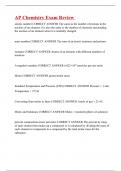
-
AP Chemistry Exam Review
- Tentamen (uitwerkingen) • 33 pagina's • 2023
- Ook in voordeelbundel
-
cracker
-
- $14.99
- + meer info
atomic number CORRECT ANSWER The same as the number of protons in the nucleus of an element; it is also the same as the number of electrons surrounding the nucleus of an element when it is neutrally charged. mass number CORRECT ANSWER The sum of an atom's neutrons and protons isotopes CORRECT ANSWER Atoms of an element with different numbers of neutrons Avogadro's number CORRECT ANSWER 6.022×10²³ particles per one mole Moles CORRECT ANSWER grams/molar mass Standard Temperatur...
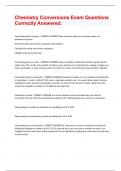
-
Chemistry Conversions Exam Questions Correctly Answered.
- Tentamen (uitwerkingen) • 3 pagina's • 2024
-
Ook in voordeelbundel
-
 ROSEGRADES
ROSEGRADES
-
- $11.99
- + meer info
Chemistry Conversions Exam Questions Correctly Answered. Converting moles to grams - CORRECT ANSWER There are three steps to converting moles of a substance to grams: Determine how many moles are given in the problem. Calculate the molar mass of the substance. Multiply step one by step two. Converting grams to moles - CORRECT ANSWER Using a calculator, divide the number of grams by the molar mass. The result is the number of moles in your element or compound. For example, imagine you ...
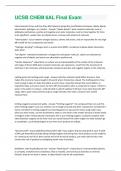
-
UCSB CHEM 6AL Final Exam Questions With 100% Correct Answers.
- Tentamen (uitwerkingen) • 16 pagina's • 2024
- Ook in voordeelbundel
-
 PatrickKaylian
PatrickKaylian
-
- $8.49
- + meer info
Intermolecular forces and how they affect physical properties /purification techniques: dipole-dipole, electrostatic, hydrogen, ion, london, - Answer-*dipole-dipole*: polar covalent molecules such as aldehydes and ketones. positive and negative end. polar molecules must be close together for force to be significant. weaker than ion-dipole forces; increase with polarity of molecule. *electrostatic*: occur between charged species, cations and anions, and are responsible for very high MP and B...
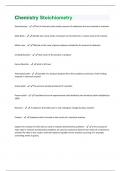
-
Chemistry Stoichiometry Questions And Answers Graded A+
- Tentamen (uitwerkingen) • 2 pagina's • 2024
- Ook in voordeelbundel
-
 PatrickKaylian
PatrickKaylian
-
- $7.99
- + meer info
Stoichiometry - Part of chemistry that studies amount of substances that are involved in reactions Mole Ratio - Identify how many moles of product are formed from a certain amount of reactant. Molar mass - Defined as the mass of given substance divided by its amount of substance Limiting Reaction - How much of the product is produce Excess Reaction - what is left over Theoretical yield - Quantify of a product obtained from the complete conversion of the limiting reactant in chemical reacti...
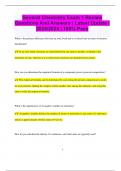
-
General Chemistry Exam 1 Review Questions And Answers | Latest Update | 2024/2025 | 100% Pass
- Tentamen (uitwerkingen) • 16 pagina's • 2024
- Ook in voordeelbundel
-
 SterlingScores
SterlingScores
-
- $9.98
- + meer info
General Chemistry Exam 1 Review Questions And Answers | Latest Update | 2024/2025 | 100% Pass What is the primary difference between an ionic bond and a covalent bond in terms of electron distribution? In an ionic bond, electrons are transferred from one atom to another, resulting in the formation of ions, whereas in a covalent bond, electrons are shared between atoms. How can you determine the empirical formula of a compound given its percent composition? The empirical formula...
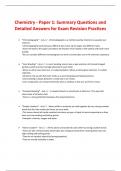
-
Chemistry - Paper 1: Summary Questions and Detailed Answers for Exam Revision Practices
- Tentamen (uitwerkingen) • 7 pagina's • 2024
- Ook in voordeelbundel
-
 Besttutors
Besttutors
-
- $7.99
- + meer info
*Chromatography* - Ans .-Chromatography is a method used by chemists to separate out mixtures. -Chromatography works because different dyes move up the paper and different rates. -Some will stick to the paper and others will dissolve more readily in the solvent and travel more quickly. -You can com[are different chromatograms to work out what dyes are in the unknown substance. *Ionic Bonding* - Ans .-In ionic bonding, atoms lose or gain electrons to formed charged particles which are...
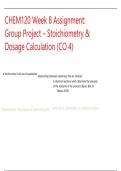
-
CHEM120 Week 8 Assignment: Group Project – Stoichiometry & Dosage Calculation (CO 4)
- Overig • 20 pagina's • 2024
-
Ook in voordeelbundel
-
 DocEdyth
DocEdyth
-
- $13.99
- + meer info
● Stoichiometry is the use of quantitative relationships between substances that are involved in chemical reactions which determine the amounts of the reactants or the products (Bauer, Birk, & Mar ks, 2019). Stoichiometry - the process of determining the amounts of substances in a chemical reaction (Bauer, Birk, & Marks, 2019). ● It is used to relate the reactants and products by using calculations and balanced equations (Bauer, Birk, & Marks, 2019). ● By knowing the amount of a reactant o...
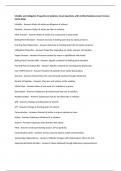
-
Molality and Colligative Properties in Solutions- Exam Questions with Verified Solutions Latest Version (2025-2026)
- Tentamen (uitwerkingen) • 3 pagina's • 2025
-
 TutorJosh
TutorJosh
-
- $9.49
- + meer info
Molality and Colligative Properties in Solutions- Exam Questions with Verified Solutions Latest Version () Molality - Answers Moles of solute per kilogram of solvent. Molarity - Answers Moles of solute per liter of solution. Mole Fraction - Answers Ratio of moles of a component to total moles. Boiling Point Elevation - Answers Increase in boiling point due to solute presence. Freezing Point Depression - Answers Decrease in freezing point due to solute presence. Colligative Properties - Ans...

Studiestress? Voor verkopers op Stuvia zijn dit juist gouden tijden. KA-CHING! Verdien ook aan je samenvattingen en begin nu met uploaden. Ontdek alles over verdienen op Stuvia


